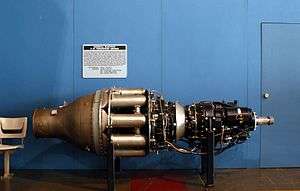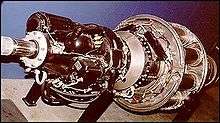General Electric T31
The General Electric T31 (company designation TG-100) was the first turboprop engine designed and built in the United States.
| T31 | |
|---|---|
 | |
| A T31 in the Presidential Gallery of the National Museum of the United States Air Force | |
| Type | Turboprop |
| National origin | United States |
| Manufacturer | General Electric |
| First run | May 1945 |
| Major applications | Consolidated Vultee XP-81 Ryan XF2R Dark Shark |
| Number built | 28 |
Design and development
The TG-100 benefited from the Anglo/American technology exchange with one of its designers, Glenn Warren, stating that one of the most important British contributions was the concept of multiple combustion cans.[1] The GE axial compressor design was directly influenced by NACA with their 8-stage compressor.[1] NACA had developed the theory and designed and tested the compressor.[2] The General Electric XT31 was first used in the experimental Consolidated Vultee XP-81.[3] The XP-81 first flew in December 1945, the first aircraft to use a combination of turboprop and turbojet power.

The T31 engine was the first American turboprop engine to power an aircraft.[4] It made its initial flight in the Consolidated Vultee XP-81 on 21 December 1945. The T31 was mounted in the nose; an Allison J33 turbojet engine mounted in the rear fuselage provided added thrust. The T31 was also used on the Navy XF2R-1, similarly powered by a turboprop/turbojet engine combination. The engine was to have been flown experimentally on a Curtiss XC-113 (a converted Curtiss C-46), but the experiment was abandoned after the XC-113 was involved in a ground accident. Only 28 T31s were built; none were used in production aircraft, but improved production turboprop engines were developed from the technology pioneered by the T31.
A derivative of the T31, the General Electric TG-110, given the military designation T41, was ordered but subsequently cancelled.
Applications
- Consolidated Vultee XP-81
- Curtiss-Wright XC-113
- Ryan XF2R Dark Shark
Specification (XT31)

Data from World Encyclopaedia of Aero Engines 5th Ed.[5]
General characteristics
- Type: Turboprop
- Length:
- Diameter:
- Dry weight: 1,980 lb (900 kg)
Components
- Compressor: 14-stage axial
- Combustors: 8 can combustion chambers
- Turbine: axial single-stage
- Fuel type: Kerosene
- Oil system: pressure spray
Performance
- Maximum power output: 2,300 hp (1,700 kW) (shp) (design) at 13,000 rpm. (1,145 propeller rpm)
- Residual thrust: 600 lbf (2.7 kN)
- Reduction gear ratio: 0.0881:1
- Power-to-weight ratio: 1.162 hp/lb (1.910 kW/kg)
See also
Related development
- General Electric J35
Comparable engines
Related lists
References
| Wikimedia Commons has media related to General Electric T31. |
- Dawson, Virginia P. SP-4306 Engines and Innovation: Lewis Laboratory and American Propulsion Technology ch3: Jet Propulsion: Too Little, Too Late (htm). NASA. Retrieved 19 October 2018.
- Sinnette, John T. Jr.; Schey, Oscar W.; King, J. Austin (1943). "Report 758:Performance of 8-stage axial comptressor designed on the basis of airfoil theory" (pdf). NACA. NACA.
- Wegg, John. General Dynamics aircraft and their predecessors. Naval Institute Press. pp. 178–180. ISBN 0-87021-233-8.
- "General Electric T31". National Museum of the US Air Force™. 5 October 2013. Retrieved 19 October 2018.
- Gunston, Bill (2006). World Encyclopaedia of Aero Engines (5th ed.). Stroud: Sutton Publishing. pp. 79–80. ISBN 978-0-7509-4479-3.